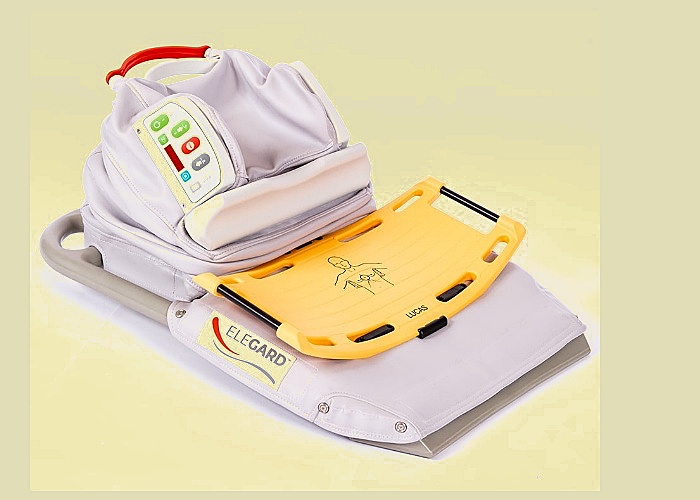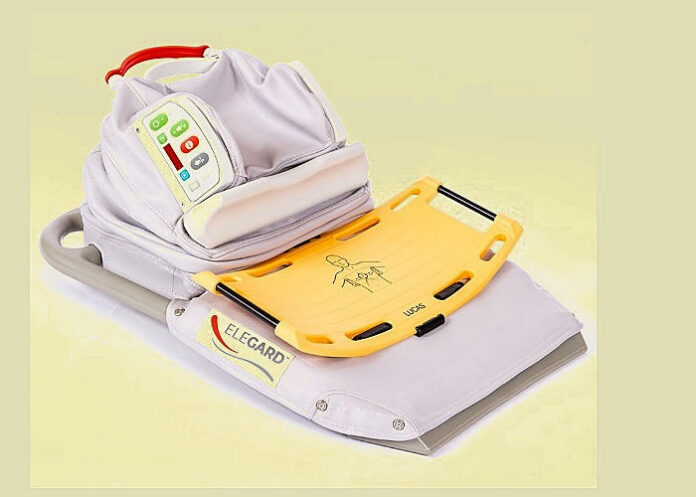An “indispensable” device that raises the head during CPR to improve blood circulation significantly boosted the likelihood that patients in out-of-hospital cardiac arrest (OHCA) reached neurologically intact recovery, according a Resuscitation study. However, an EMS expert consultant has disputed the study and questioned the findings.
Patients who received CPR along with the EleGARD “head-up” device were more likely than those in a comparison group to reach “neuro-intact” survival”, according to Dr Paul Pepe of the UT Health Science Center, Houston. Specifically: CPR started within 13 minutes of the 911 call: odds ratio 2.68; CPR started within 8 minutes of the 911 call: OR 4.74. ORs were calculated after adjusting for factors such as age, sex, and use of bystander CPR, Pepe said.
Although the device is “USFDA-cleared” per developer AdvancedCPR Solutions, it has not been tested in a randomised clinical trial (RCT), Pepe told MedPage Today.
Still, Pepe said the findings suggest it should become a standard part of fire truck equipment, “just like the ladder”. Pepe is also medical director for Dallas County Emergency Medical Services.
The device aims to improve the low survival rates in patients who have CPR after OHCA. Poor blood flow is a key problem, he said, since blood can remain pooled in the head during CPR instead of returning to the heart for recirculation. “We’ve got to get more blood out of the head and into the chest,” he said.
The EleGARD Patient Positioning System slowly raises the head by ballooning over 2 minutes, after an initial 2-minute pump-priming period of CPR, Pepe said.
The current study is based in part on observational data from a January 2022 Resuscitation study in which researchers tracked 227 patients, who received CPR with the assistance of the device during treatment, by six first-responder or emergency medical services (EMS) agencies. All patients were also treated with an automated chest-pumper (Lucas device) and an impedance threshold valve designed to boost circulation.
“Faster time to deployment of an AHUP [automated head up position] based bundle of care is associated with higher incidence of ROSC [return of spontaneous circulation],” according to those authors.
Pepe’s group matched the 227 patients to a comparison/control group (n=930) in a propensity analysis using data from an AHUP registry. “For rigorous comparisons, conventional CPR…controls were derived from 3 large-scale published OHCA trials involving 5,330 patients from high-performance EMS systems, including those that closely monitored, recorded and reported quality of CPR,” the authors stated.
He reported that, among patients treated in <13 minutes, about 11% of patients in the device group reached neuro-intact survival versus about 5% in the comparison group. In those treated in <8 minutes, the percentages were about 22% and about 5%, respectively.
“If you get this on board within 8 to 9 minutes of someone calling 911, you can get four to five times the rate of neurologically intact survival,” Pepe said. “Even at 18 minutes, it’s better than the conventional treatment.”
AdvancedCPR Solutions reported in 2021 that it had received $1.4m in federal research and development grants for the technology.
But in a 2019 Paramedic Chief Leadership Briefing article, EMS consultant William Toon, EdD, NRP, said the device was not ready for general use. He confirmed to MedPage Today that he still hasn’t changed his opinion on that, adding that it is still not known if combining the EleGARD device with the automated chest-pumper and impedance threshold valve would actually affect patient survival.
“Not one paper has yet demonstrated that this bundle is superior to an EMS system utilising high-performance CPR within a well-organised cardiac arrest system,” he said.
He also questioned investing in a device that had not been tested in an RCT (a pilot study has been done in France; one of Pepe’s co-authors is involved in the French study).
Combined, the EleGARD device, automated chest-pumper, and valve will cost about $7,500, he said, “and this doesn't include the hidden cost of the total amount of equipment needed on each ambulance, the back-stock needed, and the cost of initial and ongoing training needed by the EMS agency personnel to successfully implement this bundle of care”.
That hasn’t stopped some institutions from adopting the system.
Pepe said no RCT of the full bundle is planned at this time. In response to Toon’s comments, he said studies in cardiac arrest are difficult to control, due to the variations in factors like how patients are ventilated or given CPR. Also, top statisticians recommended the propensity-matched approach used in this study, he said.
Pepe said the current study does, in fact, compare device results to conventional CPR in high-performing systems. As for cost, Pepe said there’s not much extra expense for training, and the overall cost is quite small in light of the high cost of buying and operating fire engines.
Study details
Faster time to automated elevation of the head and thorax during cardiopulmonary resuscitation increases the probability of return of spontaneous circulation
Johanna Moore, Sue Duval, Charles Lick, Joseph Holley, Kenneth Scheppke, Bayert Salverda, Carolina Rojas-Salvador, Michael Jacobs, Paul Nystrom, Ryan Quinn, Paul Adams, Guillaume Debaty, Mack Hutchison, Charles Mason, Eduardo Martinez, Steven Mason, Armando Clift, Peter Antevy, Paul Pepe.
Published in Resuscitation on 1 January 2022
Abstract
Objectives
Resuscitation in the Head Up position improves outcomes in animals treated with active compression decompression cardiopulmonary resuscitation and an impedance threshold device (ACD + ITD CPR). We assessed impact of time to deployment of an automated Head Up position (AHUP) based bundle of care after out-of-hospital cardiac arrest on return of spontaneous circulation (ROSC).
Methods
Observational data were analysed from a patient registry. Patients received treatment with 1) ACD + and/or automated CPR 2) an ITD and 3) an AHUP device. Probability of ROSC (ROSCprob) from the 9-1-1 call to AHUP device placement was assessed with a restricted cubic spline model and linear regression.
Results
Of 11 sites, 6 recorded the interval from 9-1-1 to AHUP device (n = 227). ROSCprob for all rhythms was 34%(77/227). Median age (range) was 66 years (19-101) and 68% men. The ROSCprob for shockable rhythms was 47%(18/38). Minutes from 9-1-1 to AHUP device (median, range) varied between sites: 1) 6.4(4,15), 2) 8.0(5,19), 3) 9.9(4, 12), 4) 14.1(6, 36), 5) 15.9(6, 34), 6) 19.0(8, 38),(p = 0.0001). ROSCprob also varied; 1) 55.1%(16/29), 2) 60%(3/5), 3) 50%(3/6), 4) 22.7%(17/75), 5) 26.4%(9/34), and 6) 37.1%(29/78), (p = 0.019). For all rhythms between 4 and 12 min (n = 85), ROSCprob declined 5.6% for every minute elapsed (p = 0.024). For shockable rhythms, between 6 and 15 min (n = 23), ROSCprob declined 9.0% for every minute elapsed (p = 0.006).
Conclusions
Faster time to deployment of an AHUP based bundle of care is associated with higher incidence of ROSC. This must be considered when evaluating and implementing this bundle.

See more from MedicalBrief archives:
Bystander use of AEDs doubles cardiac arrest survival rates
Optimal CPR compression rate and depth for neurologically intact survival — NIH study
Simpler CPR techniques encourages the public to intervene

